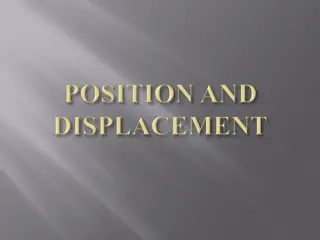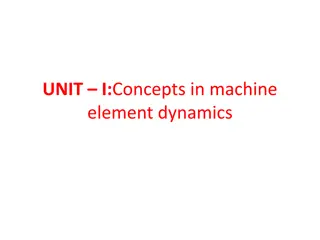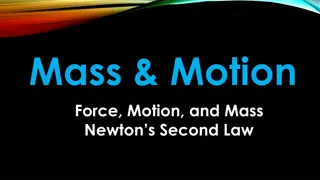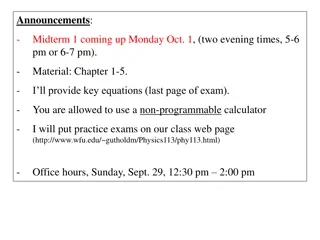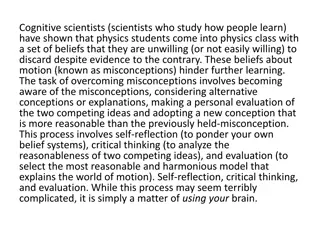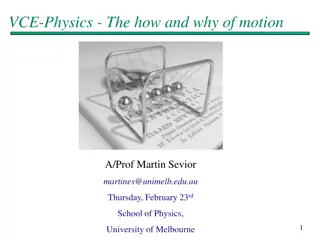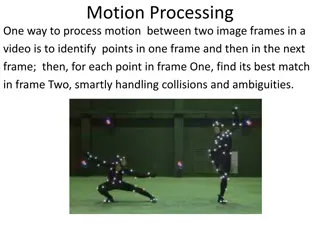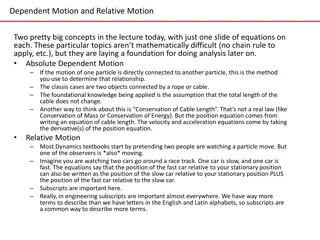Understanding Gyroscopic Couple and Precessional Motion in Second Semester Physics
Exploring the concepts of gyroscopic couple and precessional motion in the second semester of Physics, this content delves into the angular acceleration, vector diagrams, and components of angular acceleration. It also discusses the gyroscopic couple's impact on objects like a spinning disc and aeroplane. Illustrated with diagrams and explanations, this study helps comprehend the complex dynamics involved.
Uploaded on Sep 30, 2024 | 0 Views
Download Presentation

Please find below an Image/Link to download the presentation.
The content on the website is provided AS IS for your information and personal use only. It may not be sold, licensed, or shared on other websites without obtaining consent from the author. Download presentation by click this link. If you encounter any issues during the download, it is possible that the publisher has removed the file from their server.
E N D
Presentation Transcript
second Semester chapter one Gyroscopic Couple and Precessional Motion DR. ADIL ABED NAYEEIF 2019-2020
Precessional Angular Motion We have already discussed that the angular acceleration is the rate of change of angular velocity with respect to time. It is a vector quantity and may be represented by drawing a vector diagram with the help of right hand screw rule (a) (b) Consider a disc, as shown in Figure (a), revolving or spinning about the axis OX (known as axis of spin) in anticlockwise when seen from the front, with an angular velocity in a plane at right angles to the paper. After a short interval of time t, let the disc be spinning about the new axis of spin OX(at an angle angular velocity ( + + ). Using the right hand screw rule, initial angular velocity of the disc ( ) is represented by vector ox; and the final angular velocity of the disc ( + + ) is represented by vector oxas shown in Figure (b). The vector xxrepresents the change of angular velocity in time t i.e. the angular acceleration of the disc. This may be resolved into two components, one parallel to ox and the other perpendicular to ox. ) with an
Component of angular acceleration in the direction of ox, ( ) + = + cos cos cos xr or ox o x ox cos = = = = t t t t t t Since is very small, therefore substituting cos = 1, we have In the limit, when t 0 , = + = t t t d = = Ltt 0 t dt t Component of angular acceleration in the direction perpendicular to ox, ( ) t + = + x r o x sin sin sin sin = = = t t t C Since in very small, therefore substituting sin = , we have + = = t t C In the limit, when t 0 , d = = = Lt 0 t dt C t P
Gyroscopic Couple Consider a disc spinning with an angular velocity rad/s about the axis of spin OX, in anticlockwise direction when seen from the front, as shown in Figure (a). Since the plane in which the disc is rotating is parallel to the plane YOZ, therefore it is called plane of spinning. The plane XOZ is a horizontal plane and the axis of spin rotates in a plane parallel to the horizontal plane about an axis OY. In other words, the axis of spin is said to be rotating or processing about an axis OY. In other words, the axis of spin is said to be rotating or processing about an axis OY (which is perpendicular to both the axes OX and OZ) at an angular velocity P rap/s. This horizontal plane XOZ is called plane of precession and OY is the axis of precession. I = Mass moment of inertia of the disc about OX, and = Angular velocity of the disc. Angular momentum of the disc = I. Since the rate of change of angular momentum will result by the application of a couple to the disc, therefore the couple applied to the disc causing precession, C =I P
Effect of the Gyroscopic Couple on an Aeroplane The top and front view of an aeroplane are shown in Figure. Let engine or propeller rotates in the clockwise direction when seen from the rear or tail end and the aeroplane takes a turn to the left. = Angular velocity of the engine in rad/s, m = Mass of the engine and the propeller in kg, k = Its radius of gyration in metres, I = Mass moment of inertia of the engine and the propeller in kg.m2 = m.k2, v = Linear velocity of the aeroplane in m/s, R = Radius of curvature in metres, and P = Angular velocity of precession, v P= R Gyroscopic couple acting on the aeroplane, C = I. . P
Terms Used in a Naval Ship The top and front views of a naval ship are shown in Figure. The fore end of the ship is called bow and the rear end is known as stern or aft. The left hand and right hand sides of the ship, when viewed from the stern are called port and star-board respectively. We shall now discuss the effect of gyroscopic couple on the naval ship in the following three cases: 1. Steering, 2. Pitching, and 3. Rolling.
Effect of Gyroscopic Couple on a Naval Ship during Steering Steering is the turning of a complete ship in a curve towards left or right, while it moves forward. Consider the ship taking a left turn, and rotor rotates in the clockwise direction when viewed from the stern, as shown in Figure. The effect of gyroscopic couple on a naval ship during steering taking left or right turn may be obtained in the similar way as for an aeroplane as discussed .
Effect of Gyroscopic Couple on a Naval Ship during Pitching Pitching is the movement of a complete ship up and down in a vertical plane about transverse axis, as shown in Figure . In this case, the transverse axis is the axis of precession. The pitching of the ship is assumed to take place with simple harmonic motion i.e. the motion of the axis of spin about transverse axis is simple harmonic. Angular displacement of the axis of spin from mean position after time t seconds, = = sin 1. t = Amplitude of swing i.e. maximum angle turned from the mean position in radians, and 1= Angular velocity of S.H.M. 2 2 = = rad / sec Time Period S H M in ond t . . sec 1 P Angular velocity of precession, d dt d ( ) = = = t t sin . cos . dt P 1 1 1
The angular velocity of precession will be maximum, if cos 1.t = 1. Maximum angular velocity of precession, Pmax = 1 = / tp I = Moment of inertia of the rotor in kg.m2 , and = Angular velocity of the rotor in rad/s. Mamimum gyroscopic couple, Cmax = I. Pmax The angular acceleration during pitching, d sin 1 1 2 = = 2 t . 2 dt The angular acceleration is maximum, if sin 1t = 1. Maximum angular acceleration during pitching, max = ( 1)2
Effect of Gyroscopic Couple on a Naval Ship during Rolling We know that, for the effect of gyroscopic couple to occur, the axis of precession should always be perpendicular to the axis of spin. If, however, the axis of precession becomes parallel to the axis of spin, there will be no effect of the gyroscopic couple acting on the body of the ship. In case of rolling of a ship, the axis of precession (i.e. longitudinal axis) is always parallel to the axis of spin for all positions. Hence, there is no effect of the gyroscopic couple acting on the body of a ship.
Stability of a Four Wheel Drive Moving in a Curved Path Consider the four wheels A, B, C and Dof an automobile locomotive taking a turn towards left as shown in Figure. The wheels A and C are inner wheels, whereas B and D are outer wheels. The centre of gravity (C.G.) of the vehicle lies vertically above the road surface m = Mass of the vehicle in kg, W = Weight of the vehicle in newtons = m.g, rW = Radius of the wheels in metres, R = Radius of curvature in metres (R > rW), h = Distance of centre of gravity, vertically above the road surface in metres, x = Width of track in metres, IW = Mass moment of inertia of one of the wheels in kg-m2. W = Angular velocity of the wheels or velocity of spin in rad/s, IE = Mass moment of inertia of the rotating parts of the engine in kg-m2, E = Angular velocity of the rotating parts of the engine in rad/s, G = Gear ratio = E / W, v = Linear velocity of the vehicle in m/s = W.rW
A little considereation will show, that the weight of the vehicle (W) will be equally distributed over the four wheels which will act downwards. The reaction between each wheel and the road surface of the same magnitude will act upwards. Therefore Road reaction over each wheel = W/4 = m.g /4 newtons Let us now consider the effect of the gyroscopic couple and centrifugal couple on the vehicle. 1. Effect of the gyroscopic couple Since the vehicle takes a turn towards left due to the precession and other rotating parts, therefore a gyroscopic couple will act. We know that velocity of precession, P = v/R Gyroscopic couple due to 4 wheels, CW = 4 IW. W. P and gyroscopic couple due to the rotating parts of the engine, CE = IE. E. P = IE.G. W. P Net gyroscopic couple, C = CW CE = 4 IW. W. P IE.G. W. P = W. P (4 IW G.IE) The positive sign is used when the wheels and rotating parts of the engine rotate in the same direction. If the rotating parts of the engine revolves in opposite direction, then negative sign is used.
Due to the gyroscopic couple, vertical reaction on the road surface will be produced. The reaction will be vertically upwards on the outer wheels and vertically downwards on the inner wheels. Let the magnitude of this reaction at the two outer or inner wheels be P newtons. Then P x = C or P = C/x Vertical reaction at each of the outer or inner wheels, P /2 = C/ 2x when rotating parts of the engine rotate in opposite directions, then ve sign is used, i.e. net gyroscopic couple, C = CW CE When CE > CW, then C will be ve. Thus the reaction will be vertically downwards on the outer wheels and vertically upwards on the inner wheels. 2. Effect of the centrifugal couple Since the vehicle moves along a curved path, therefore centrifugal force will act outwardly at the centre of gravity of the vehicle. The effect of this centrifugal force is also to overturn the vehicle. We know that centrifugal force, V m FC = 2 R m V 2 = = C F h h The couple tending to overturn the vehicle or overturning couple, R o C
This overturning couple is balanced by vertical reactions, which are vertically upwards on the outer wheels and vertically downwards on the inner wheels. Let the magnitude of this reaction at the two outer or inner wheels be Q. Then h V m X . Vertical reaction at each of the outer or inner wheels, C . . 2 = = = Q X C or Q O Q 2 m 2 V . h . R X O 2 = R X . Total vertical reaction at each of the outer wheel, W P Q = + + PO 4 2 2 and total vertical reaction at each of the inner wheel, Q P W PI = 4 2 2
Examples Exam (1)A uniform disc of 150 mm diameter has a mass of 5 kg. It is mounted centrally in bearings which maintain its axle in a horizontal plane. The disc spins about it axle with a constant speed of 1000 r.p.m. while the axle precesses uniformly about the vertical at 60 r.p.m. If the distance between the bearings is 100 mm, find the resultant reaction at each bearing due to the mass and gyroscopic effects. Solution. Given: d = 150 mm or r = 75 mm = 0.075 m ; m = 5 kg ; N = 1000 r.p.m. or = 1000/60 = 104.7 rad/s (anticlockwise); NP = 60 r.p.m. or P = 2 60/60 = 6.284 rad/s (anticlockwise); x = 100 mm = 0.1 m We know that mass moment of inertia of the disc, about an axis through its centre of gravity and perpendicular to the plane of disc, I = m.r2/2 = 5 (0.075)2/2 = 0.014 kg m2 Gyroscopic couple acting on the disc, C = I. P = 0.014 104.7 6.284 = 9.2 N.m The direction of the reactive gyroscopic couple is shown in Figure. Let F be the force at each bearing due to the gyroscopic couple.
F = C/x = 9.2/0.1 = 92 N The force F will act in opposite directions at the bearings as shown in Figure. Now let RAand RBbe the reaction at the bearing A and B respectively due to the weight of the disc. Since the disc is mounted centrally in bearings, therefore, RA = RB = 5/2 = 2.5 kg = 2.5 9.81 = 24.5 N Let RA1 and RB1= Resultant reaction at the bearings A and B respectively.Since the reactive gyroscopic couple acts in clockwise direction when seen from the front, therefore its effect is to increase the reaction on the left hand side bearing (i.e. A) and to decrease the reaction on the right hand side bearing (i.e. B). RA1 = F + RA = 92 + 24.5 = 116.5 N (upwards) Ans. and RB1 = F RB = 92 24.5 = 67.5 N (downwards) Ans.
Exam(2) An aeroplane makes a complete half circle of 50 metres radius, towards left,when flying at 200 km per hr. The rotary engine and the propeller of the plane has a mass of 400 kg and a radius of gyration of 0.3 m. The engine rotates at 2400 r.p.m. clockwise when viewed from the rear. Find the gyroscopic couple on the aircraft and state its effect on it. Solution. Given : R = 50 m ; v = 200 km/hr = 55.6 m/s ; m = 400 kg ; k = 0.3 m ; N = 2400 r.p.m. or = 2 2400/60 = 251 rad/s We know that mass moment of inertia of the engine and the propeller, I = m.k2= 400(0.3)2= 36 kg.m2 and angular velocity of precession, P = v/R = 55.6/50 = 1.11 rad/s We know that gyroscopic couple acting on the aircraft, C = I. P = 36 251.4 1.11 = 100 46 N.m = 10.046 kN.mAns.
Exam(3) The turbine rotor of a ship has a mass of 3500 kg. It has a radius of gyration of 0.45 m and a speed of 3000 r.p.m. clockwise when looking from stern. Determine the gyroscopic couple and its effect upon the ship: 1. when the ship is steering to the left on a curve of 100 m radius at a speed of 36 km/h. 2. when the ship is pitching in a simple harmonic motion, the bow falling with its maximum velocity. The period of pitching is 40 seconds and the total angular displacement between the two extreme positions of pitching is 12 degrees. Solution. Given : m = 3500 kg ; k = 0.45 m; N = 3000 r.p.m. or = 3000/60 = 314.2 rad/s 1. When the ship is steering to the left Given: R =100 m ; v = km/h = 10 m/s We know that mass moment of inertia of the rotor, I = m.k2= 3500 (0.45)2= 708.75 kg.m2 and angular velocity of precession, P = v/R = 10/100 = 0.1 rad/s Gyroscopic couple, C = I. P = 708.75 314.2 0.1 = 22 270 N.m = 22.27 kN.m Ans.
2. When the ship is pitching with the bow falling Given: tp = 40 s Since the total angular displacement between the two extreme positions of pitching is 12 (i.e. 2 = 12 ), therefore amplitude of swing, = 12 / 2 = 6 = 6 /180 = 0.105 rad and angular velocity of the simple harmonic motion, = / tp = 2 / 40 = 0.157 rad/s We know that maximum angular velocity of precession, P = 1 = 0.105 0.157 = 0.0165 rad/s Gyroscopic couple, C = I. P = 708.75 314.2 0.0165 = 3675 N.m = 3.675 kN.m Ans.
Exam(4). A rear engine automobile is travelling along a track of 100 metres mean radius. Each of the four road wheels has a moment of inertia of 2.5 kg.m2and an effective diameter of 0.6 m. The rotating parts of the engine have a moment of inertia of 1.2 kg.m2. The engine axis is parallel to the rear axle and the crankshaft rotates in the same sense as the road wheels. The ratio of engine speed to back axle speed is 3 : 1. The automobile has a mass of 1600 kg and has its centre of gravity 0.5 m above road level. The width of the track of the vehicle is 1.5 m. Determine the limiting speed of the vehicle around the curve for all four wheels to maintain contact with the road surface. Assume that the road surface is not cambered and centre of gravity of the automobile lies centrally with respect to the four wheels. Solution. Given : R = 100 m ; IW = 2.5 kg-m2 ; dW = 0.6 m or rW = 0.3 m ; IE = 1.2 kg.m2 ; G = E/ W = 3 ; m = 1600 kg ; h = 0.5 m ; x = 1.5 m The weight of the vehicle (m.g) will be equally distributed over the four wheels which will act downwards. The reaction between the wheel and the road surface of the same magnitude will act upwards. Road reaction over each wheel = W/4 = m.g / 4 = 1600 9.81/4 = 3924 N v = Limiting speed of the vehicle in m/s. We know that angular velocity of the wheels, v v = = = v rad . / sec 3 33 r . W 0 3 W
v v = = 100= v rad . / sec 0 01 and angular velocity of precession, R P Gyroscopic couple due to 4 wheels, = . . = = C I v v v N m . . . . . 4 4 2 5 0 333 0 01 0 33 2 W W W P and gyroscopic couple due to rotating parts of the engine, CE = IE. E. P = IE.G. W. P = 1.2 3 3.33v 0.01v = 0.12 v2N.m Total gyroscopic couple C = CW + CE = 0.33 v2 + 0.12 v2= 0.45 v2N.m Due to this gyroscopic couple, the vertical reaction on the rails will be produced. The reaction will be vertically upwards on the outer wheels and vertically downwards on the inner wheels. Let the magnitude of this reaction at each of the outer or inner wheel be P/2 newtons. P/2 = C/2x = 0.45v2/2 1.5 = 0.15 v2N We know that centrifugal force, FC= m.v2/R = 1600 v2/100 = 16 v2N Overturning couple acting in the outward direction, CO= FC h = 16 v2 0.5 = 8 v2N.m This overturning couple is balanced by vertical reactions which are vertically upwards on the outer wheels and vertically downwards on the inner wheels. Let the magnitude of this reaction at each of the outer or inner wheels be Q/2 newtons.
Q / 2 = CO / 2x = 8 v2/ 2 1.5 = 2.67 v2N We know that total vertical reaction at each of the outer wheels, W P Q = + + PO 4 2 2 and total vertical reaction at each of the inner wheels, W P Q W P Q = = + PI 4 2 2 4 2 2 From equation abovewe see that there will always be contact between the outer wheels and the road surface because W/4, P/2 and Q/2 are vertically upwards. In order to have contact between the inner wheels and road surface, the reactions should also be vertically upwards, which is only possible if W P Q + 0.15 v2+ 2.67 v2 3924 or 2.82 v2 3924 4 2 2 V2 3924/2.82 = 1391.5 v 37.3 m/s = 37.3 3600 / 1000 = 134.28 km/h Ans.
Exercises Q1/ A flywheel of mass 10 kg and radius of gyration 200 mm is spinning about its axis, which is horizontal and is suspended at a point distant 150 mm from the plane of rotation of the flywheel. Determine the angular velocity of precession of the flywheel. The spin speed of flywheel is 900 r.p.m. Q2/ The mass of a turbine rotor of a ship is 8 tonnes and has a radius of gyration 0.6 m. It rotates at 1800 r.p.m. clockwise when looking from the stern. Determine the gyroscopic effects in the following cases: 1. If the ship travelling at 100 km / h strees to the left in a curve of 75 m radius, 2. If the ship is pitching and the bow is descending with maximum velocity. The pitching is simple harmonic, the periodic time being 20 seconds and the total angular movement between the extreme positions is 10 , and 3. If the ship is rolling and at a certain instant has an angular velocity of 0.03 rad/s clockwise when looking from stern. Q3/ An aeroplane makes a complete half circle of 50 metres radius, towards left, when flying at 200 km per hour. The rotary engine and the propeller of the plane has a mass of 400 kg with a radius of gyration of 300 mm. The engine runs at 2400 r.p.m. clockwise, when viewed from the rear. Find the gyroscopic couple on the aircraft and state its effect on it.
Q4/ A four wheeled motor car of mass 2000 kg has a wheel base 2.5 m, track width 1.5 m and height of centre of gravity 500 mm above the ground level and lies at 1 metre from the front axle. Each wheel has an effective diameter of 0.8 m and a moment of inertia of 0.8 kg.m2. The drive shaft, engine flywheel and transmission are rotating at 4 times the speed of road wheel, in a clockwise direction when viewed from the front, and is equivalent to a mass of 75 kg having a radius of gyration of 100 mm. If the car is taking a right turn of 60 m radius at 60 km/h, find the load on each wheel. Q5/ A four-wheeled trolley car of total mass 2000 kg running on rails of 1.6 m gauge, rounds a curve of 30 m radius at 54 km/h. The track is banked at 8 . The wheels have an external diameter of 0.7 m and each pair with axle has a mass of 200 kg. The radius of gyration for each pair is 0.3 m. The height of centre of gravity of the car above the wheel base is 1 m. Determine, allowing for centrifugal force and gyroscopic couple actions, the pressure on each rail.





